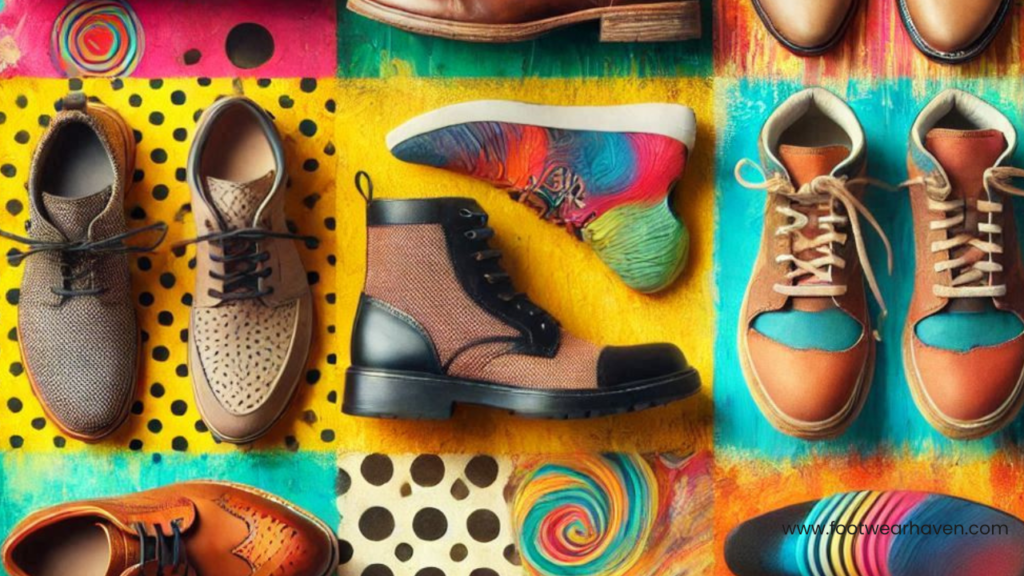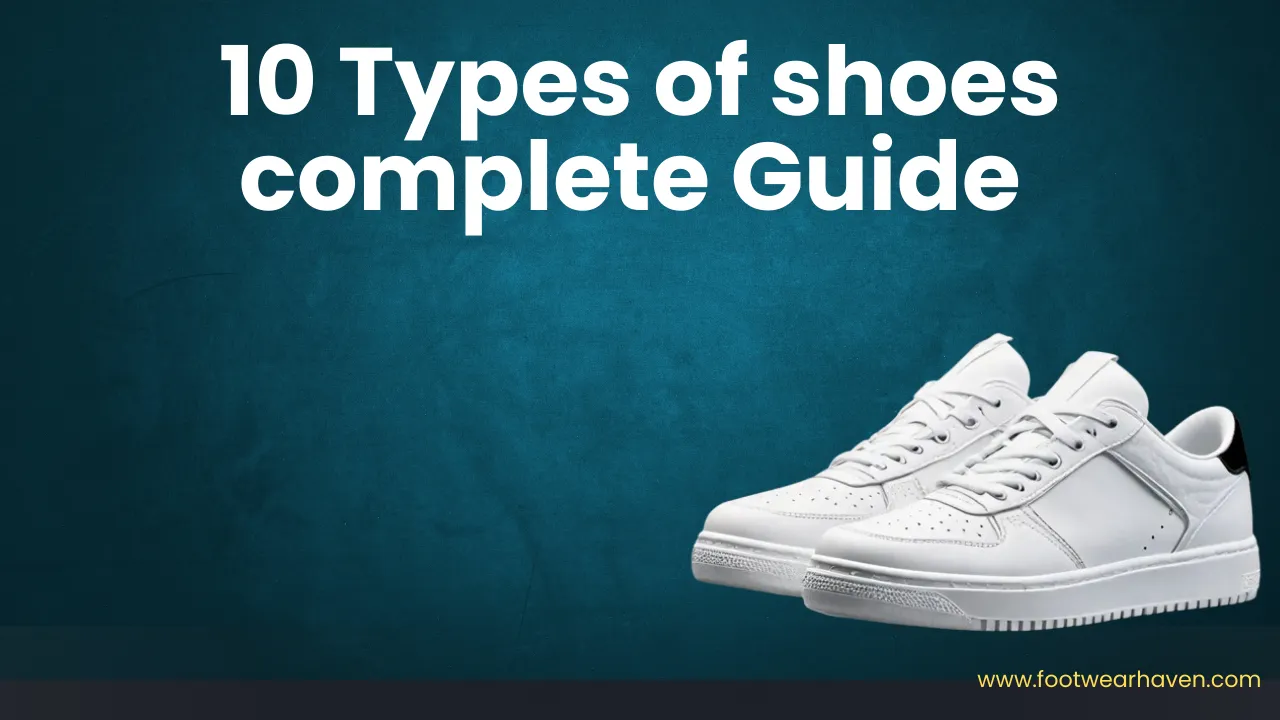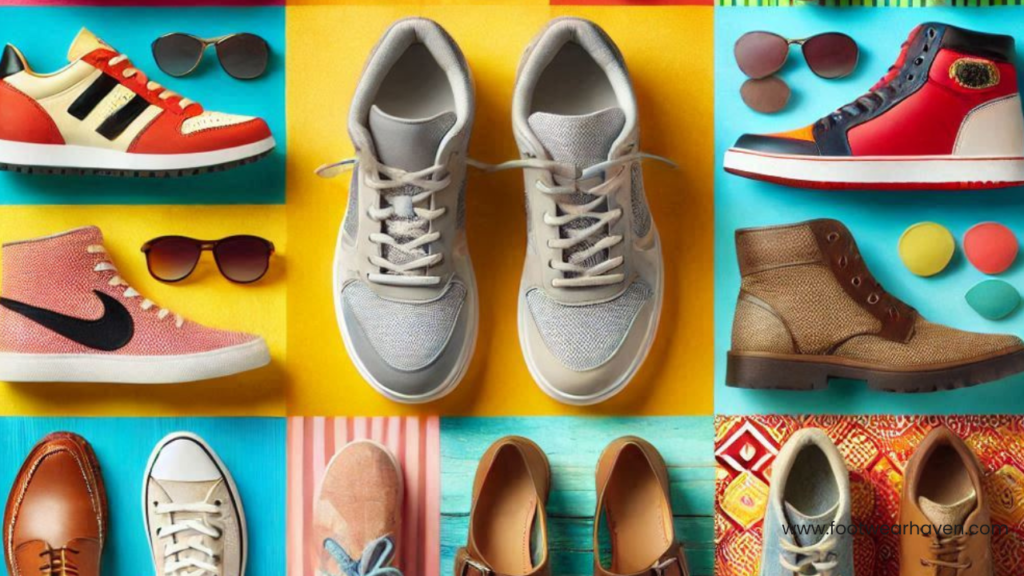Types of shoes encompass a broad range—from athletic to casual to specialised designs—each designed for a specific purpose. Whether you need running shoes, hiking boots, loafers, or cycling shoes, knowing which type best fits your activity helps you walk, run, or play with comfort, support, and style.
In this article, you’ll discover the 10 major types of shoes, why each exists, and how to choose the right one for your needs.
Table of Contents
Toggle10 Types of Shoes Everyone Should Know
1. Athletic Shoes
Athletic shoes are specifically designed for a variety of physical activities and sports. They provide the necessary support and protection to keep your feet safe during exercise or gameplay. Below are some common types of athletic shoes:
1.1 Running Shoes – Built for Speed and Cushioning
Running shoes are built to help you run effortlessly and securely. They’re particularly renowned for boosting the performance of runners, both amateur and professional. The midsole typically consists of Ethylene Vinyl Acetate (EVA) for enhanced cushioning and Polyurethane (PU) for durability.
The outsole, which makes contact with the ground, is crafted from tire-grade rubber to ensure traction on most surfaces. The upper part, made of engineered mesh, covers the top and sides of the shoe, allowing breathability during runs. Some variants have knit uppers that offer a snug fit but may compromise ventilation.
Keep in mind that cushioned shoes can cause biomechanical alterations in your body. According to a 2018 study, running shoes can also increase leg stiffness and the impact on feet, potentially affecting your body’s natural spring-like mechanics and raising the risk of injury.
1.2 Training Shoes – For Strength and Flexibility
Training shoes, also known as trainers, are more specialized compared to regular athletic shoes. While running shoes cushion forward movements, training shoes are optimized for lateral movements and high-intensity exercises. Although they are made from similar materials as running shoes, trainers often feature synthetic mesh.
While not as durable, this mesh supports dynamic movements during exercises. These are ideal for activities like gym workouts, weightlifting, aerobics, or cardio. They are designed to handle sudden foot movements during rigorous routines. However, they offer less cushioning compared to running shoes, meaning they’re not suitable for prolonged running.
1.3 Walking Shoes – Designed for Comfort and Support
For those not interested in running or training, walking shoes offer a more affordable alternative and are ideal for casual walkers. Walking shoes also qualify as athletic footwear, as they aim to make walking safe and comfortable.
They come with materials that absorb shock and reduce joint strain. Long walks in ordinary shoes can lead to discomfort in your feet, ankles, and knees. Walking shoes, equipped with ample cushioning, prevent foot fatigue and allow you to walk for longer periods.
However, these shoes are not intended for running or training. Additionally, due to their advanced cushioning and support, they can feel heavy during walks.
1.4 Hiking Boots – Built for Tough Terrains
Hiking boots are tailored for terrains where no other athletic shoe can compete. Whether you’re trekking through rocky, steep, or rugged landscapes, these boots provide the necessary support. These boots combine leather, waterproof membranes, and synthetic materials, making hiking more enjoyable by reducing foot fatigue.
The rubber soles deliver excellent traction, minimizing the risk of slipping or falling on rugged surfaces. However, there are some factors to consider before relying on these boots. Most hiking boots lack mesh, which means they can get sweaty inside.
Additionally, while waterproof membranes like Gore-Tex block external moisture, they can trap sweat, causing discomfort. Another consideration is the break-in period. Hiking boots, especially those made from leather, can feel stiff initially and may require time to mold to your foot.
1.5 Cycling Shoes – Engineered for Efficiency
Cycling shoes are engineered to enhance your cycling performance, whether you’re a professional rider or a hobbyist. They securely connect your feet to the pedals, maximizing efficiency. The sole, made from carbon fiber, ensures that your energy is efficiently transferred to the pedal.
Unlike regular shoes with flexible soles, cycling shoes don’t bend under pressure, leading to better performance. The upper part of the shoe, typically made of nylon or synthetic mesh, promotes air circulation to keep your feet cool. You can also adjust the fit mid-ride without removing the shoes.
However, one downside is that in road-type cycling shoes, the cleats (which connect to the pedals) protrude from the sole, making walking difficult. Mountain bike shoes have recessed cleats, which are more comfortable for walking, but still not ideal for long distances.
2. Casual Shoes

Casual shoes are the perfect choice for daily wear, offering comfort and style without requiring a special occasion. Below are some popular styles:
2.1 Sneakers – Stylish and Versatile Everyday Shoes
Originally designed as athletic shoes, sneakers have become a fashion staple. Once the default choice for sports, more specialized shoes have since entered the market. Basketball shoes, a specific type of sneaker, are designed to handle sudden foot movements and prevent slipping.
The term “sneakers” originated in the 19th century because of their quiet rubber soles, which don’t make noise like traditional shoes. Sneakers come in many designs, with some featuring laces and others being slip-ons. Materials range from mesh to canvas or synthetic fabrics, but they all share one trait: breathability.
One of the most appealing aspects of sneakers is their versatility. They can be paired with anything from shorts and skirts to pants and jeans. Unique styles include slip-ons, padded collars, and oversized soles. Despite their popularity, sneakers do have downsides.
Extra padding may trap heat and moisture, and flat soles may provide poor arch support. Additionally, cleaning them can be challenging for some wearers.
2.2 Loafers – The Perfect Blend of Style and Ease
Loafers, initially designed as slip-ons, quickly gained a strong presence in the fashion world. They offer unmatched versatility and comfort, suitable for men, women, and children alike. You can wear loafers all day without discomfort.
Penny loafers, featuring a band resembling a coin slot, and tassel loafers, with fringes hanging from the vamp, are just two of the many styles available. Loafers come in various materials, with rexine being the most affordable. These shoes are perfect for casual outfits and require minimal upkeep.
Leather loafers, on the other hand, are ideal for professional settings, offering a more polished and durable option. While comfortable, loafers are not suited for all environments. Unlike sneakers, they are sensitive to water and need proper care, especially those made of leather or suede.
2.3 Boat Shoes – Smart, Slip-Resistant Footwear
Boat shoes were originally created for sailors, but their practicality and style made them popular beyond the deck. Their slip-resistant sole offers safety on wet surfaces, while their moccasin-inspired design adds a touch of class. Today, boat shoes are often associated with luxury, particularly for those who own yachts.
Their rubber sole offers exceptional grip on wet surfaces, making them ideal for wearing in rainy or slippery conditions. However, many boat shoes lack arch support, which could be problematic for those with specific foot needs.
They are also designed to be worn without socks, which may cause discomfort or foot odor over time. Frequent cleaning is necessary when wearing boat shoes without socks, as the soles can get dirty easily.
2.4 Espadrilles – Lightweight and Breathable Summer Shoes
Espadrilles are lightweight, casual shoes perfect for warm weather. They are easily recognized by their jute soles and lightweight fabric upper. Originating from France and Spain in the 14th century, they were initially worn by peasants and soldiers.
Over time, espadrilles became popular with the Spanish monarchy and, by the 19th century, were embraced by artists and intellectuals. Today, despite their simple materials like jute and cotton, espadrilles are seen as luxury items. The labor-intensive handcrafting process, along with eco-friendly practices and limited production, contribute to their high price.
Synthetic options offer durability and water resistance but lack the traditional appeal. Cleaning genuine espadrilles can be tricky, as the materials are delicate and prone to damage.
2.5 Slippers – Comfort for Home and Light Outdoor Use
Slippers are the go-to footwear for home use. They are cozy, cushioned, and comfortable, offering warmth in winter and breathability in summer. There are many types of slippers, including those made from cotton, PVC, fleece, wool, and memory foam.
Some slippers, like bootie slippers, are designed for outdoor use, providing comfort and durability for short trips outside. However, they are not suited for prolonged outdoor wear and can become dirty quickly, requiring frequent cleaning
FQAs (Frequently Asked Questions)
How do I choose the right shoe type?
Match your activity (running, walking, work, outdoors) with shoes designed for that movement and surface.
Are all sneakers the same type of shoe?
No — “sneakers” is a broad category that includes running, training, fashion, and lifestyle designs.
Can one type of shoe do everything?
While cross-trainers try, it’s better to use sport-specific shoes to avoid discomfort or injury.
Conclusion
Understanding the different types of shoes helps you choose the right pair for every activity—whether it’s running, hiking, working out, or dressing up casually. Each shoe type serves a unique purpose, balancing comfort, performance, and style. Investing in the right footwear not only boosts confidence but also keeps your feet healthy and supported in every step.


